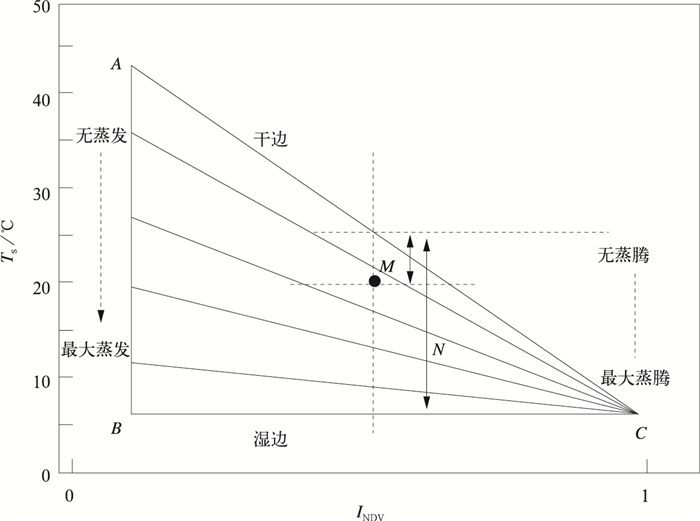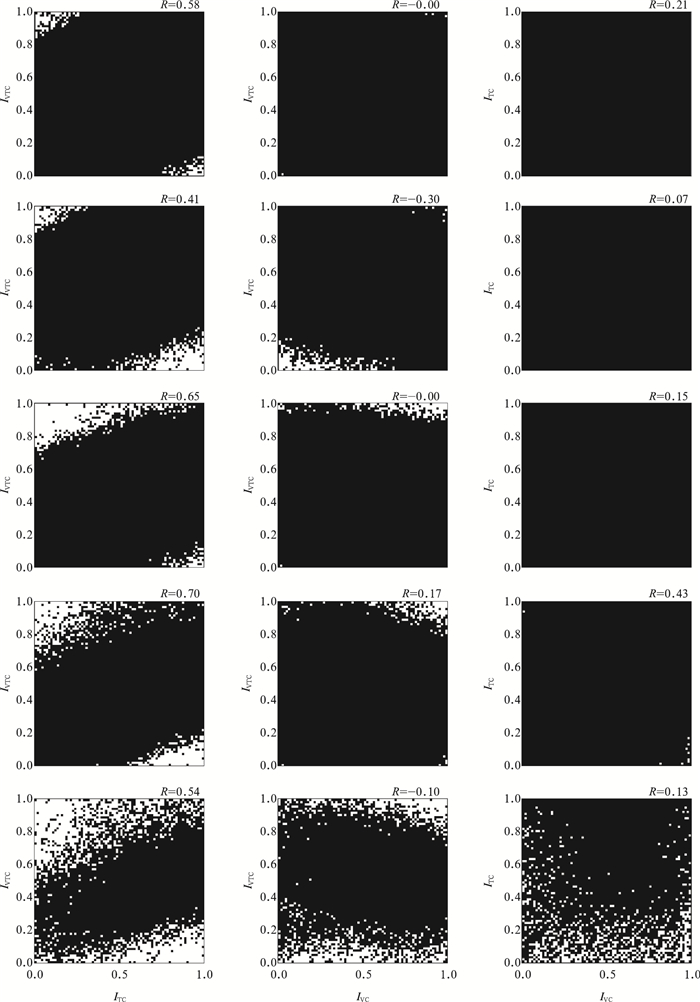Satellite Remote Sensing Drought Monitoring Methods Based on Different Biophysical Indicators
-
摘要: 采用MODIS的1 km×1 km分辨率数据,以我国黑龙江为研究区,对基于植被指数的植被状态指数 (IVC)、基于地表温度的温度状态指数 (ITC) 和基于植被指数-地表温度特征空间的植被温度状态指数 (IVTC) 与10 cm,20 cm土壤相对湿度、降水量的关系、3种指数监测结果及其相互关系进行了对比分析。结果表明:IVTC相对于ITC,IVC更适于反映土壤湿度的变化,对浅层土壤湿度更加敏感;IVTC相对于ITC,IVC对降水更敏感,与监测时段的降水和前期总体降水都密切相关;在生长季早期,IVTC和ITC用于干旱监测的适用性明显优于IVC;不同区域间,IVTC的可比性较好,IVC和ITC则较差;IVTC所反映的地表温度信息对干旱的直接指示作用最强,所反映的植被信息对干旱的直接指示作用较弱。Abstract: As a frequent natural hazard, drought causes the heaviest damage to daily life and ecological environment among all natural disasters. The large scale and dynamic drought monitoring has been frontier and hot topic in the global climate change and food security research. Satellite remote sensing is the main method of obtaining distributed information of the land surface. However, the applicability of a drought monitoring method varies by region and period. So it's necessary to inspect and evaluate the drought monitoring method to ensure the validity and accuracy in drought monitoring.Vegetation index based IVC, land surface temperature based and Surface Temperature-Normalized Difference Vegetation Index space (Ts-INDV space) based are compared to analyze and evaluate their characteristics and applicability in drought monitoring. The MODIS 16-day NDVI (MOD13A2) and 8-day Ts (MOD11A2) provided at 1 km spatial resolution as a gridded level-3 product in the Sinusoidal projection are used, and the Heilongjiang Province, the main food production area in China, is chosen as the study area. The monitoring period is from 9 May to 9 June of the year 2000 to 2008. The correlation between IVC, ITC, IVTC and relative soil moisture in 10 cm and 20 cm depth, the correlation between IVC, ITC, IVTC and the precipitation in the satellite monitoring period and the cumulative precipitation in the last 1-, 2-, 3-, 4-period time scales, the difference and the relationship between IVC, ITC, IVTC are analyzed.Significant linear correlation is found between IVTC and the relative soil moisture in 10 cm and 20 cm depth, especially for the 10 cm depth. The correlation between IVTC and relative soil moisture is obviously better than that between ITC, IVC and the relative soil moisture. So, it can be judged that IVTC may mirror the soil moisture better than IVC and ITC, and is more sensitive to shallow soil moisture. IVTC is also found linearly correlated with precipitation in current monitoring period, as well as the cumulative precipitation in the last 1-, 2-, 3-, 4-period timescales. The correlations are better than those between ITC, IVC and precipitation as well as corresponding cumulative precipitation, which show that IVTC is more sensitive to precipitation than IVC and ITC, and is closely related to not only current precipitation but also past cumulative precipitation. In the early growing season, IVTC and ITC are applicable in drought monitoring, while the fractional IVC cover is too low to monitor drought. It is difficult to compare the drought among different areas with IVC and ITC, while based on the energy conservation principle, combining the INDV and Ts, IVTC can reflect soil moisture better and is comparable in different areas. Furthermore, the land surface temperature implied by IVTC gives more direct hint of drought than the INDV implied especially on the grassland, then in the crop land, brush land and forest land in sequence.
-
表 1 129时段ITC,IVC,IVTC与土壤相对湿度的相关系数
Table 1 The correlation between ITC, IVC, IVTC and soil relative moisture in the period 129
年份
(样本数)指数 10 cm土壤相对湿度 20 cm土壤相对湿度 2000
(49)ITC 0.149 0.203 IVC 0.238* 0.111 IVTC 0.290*** 0.170 2001
(61)ITC -0.051 -0.048 IVC 0.185 0.178 IVTC 0.257** 0.210 2002
(62)ITC 0.049 0.129 IVC -0.040* -0.101 IVTC 0.139 0.177 2003
(67)ITC -0.039 -0.165 IVC -0.081 -0.107 IVTC 0.222* 0.169 2004
(68)ITC 0.129 0.084 IVC 0.002 -0.098 IVTC 0.386**** 0.338*** 2005
(66)ITC 0.300*** 0.194* IVC -0.101 -0.160 IVTC 0.330*** 0.248** 2006
(64)ITC -0.166 -0.021 IVC 0.220* 0.022 IVTC 0.279** 0.241** 2007
(69)ITC -0.217 -0.176 IVC 0.055 0.021 IVTC 0.283** 0.253* 2008
(71)ITC 0.461***** 0.398**** IVC -0.084 -0.015 IVTC 0.467***** 0.430***** 注:*****,****,***,**,*分别代表相关性通过0.001,0.01,0.02,0.05,0.1的显著性检验。 表 2 145时段ITC,IVC,IVTC与土壤相对湿度的相关系数
Table 2 The correlation between ITC, IVC, IVTC and soil relative moisture in the period 145
年份
(样本数)指数 10 cm土壤相对湿度 20 cm土壤相对湿度 2000
(43)ITC 0.305** 0.165 IVC -0.302 0.144 IVTC 0.435**** 0.294** 2001
(65)ITC 0.233** 0.037 IVC 0.109 0.037 IVTC 0.264** 0.189 2002
(60)ITC 0.132 0.119 IVC 0.232 0.298 IVTC 0.323** 0.319** 2003
(67)ITC 0.087 -0.165 IVC -0.082 0.011 IVTC 0.251** 0.160 2004
(68)ITC 0.198* 0.191 IVC 0.213* 0.198* IVTC 0.366**** 0.292*** 2005
(61)ITC 0.064 -0.045 IVC -0.233 -0.160 IVTC 0.292 0.111 2006
(72)ITC 0.037 -0.089 IVC 0.093 0.022 IVTC 0.117 0.175 2007
(70)ITC 0.099 0.148 IVC -0.235 0.021 IVTC 0.451***** 0.432***** 2008
(71)ITC 0.072 0.024 IVC 0.353***** 0.354***** IVTC 0.306**** 0.331**** 注:*****,****,***,**,*分别代表相关性通过0.001,0.01,0.02,0.05,0.1的显著性检验。 表 3 129时段ITC, IVC, IVTC与降水量的相关系数
Table 3 The correlation between ITC, IVC, IVTC and precipitation in the period 129
年份 指数 超前时段 0 1 2 3 4 2000 ITC 0.336 0.394 0.460 0.430 0.439 IVC 0.179 0.206 0.181 0.180 0.151 IVTC 0.504 0.551 0.539 0.568 0.568 2001 ITC 0.256 0.160 0.130 0.095 0.079 IVC 0.117 0.302 0.299 0.265 0.261 IVTC 0.495 0.428 0.398 0.437 0.433 2002 ITC 0.234 0.176 0.166 0.366 0.322 IVC 0.346 0.296 0.528 0.487 0.481 IVTC 0.246 0.258 0.343 0.181 0.228 2003 ITC 0.229 0.200 0.141 0.089 0.116 IVC 0.100 0.044 -0.060 -0.080 -0.090 IVTC 0.165 0.232 0.231 0.213 0.213 2004 ITC -0.090 0.039 0.028 0.050 0.068 IVC -0.157 -0.095 -0.111 -0.139 -0.142 IVTC 0.320 0.427 0.443 0.498 0.501 2005 ITC 0.603 0.582 0.523 0.548 0.527 IVC -0.022 -0.066 -0.035 -0.011 -0.002 IVTC 0.679 0.536 0.474 0.493 0.495 2006 ITC 0.125 0.125 0.062 0.032 0.030 IVC 0.149 0.295 0.278 0.263 0.256 IVTC 0.361 0.349 0.368 0.382 0.381 2007 ITC 0.160 0.059 0.185 0.189 0.200 IVC -0.010 0.055 0.071 0.112 0.095 IVTC 0.239 0.277 0.081 0.011 -0.016 2008 ITC 0.375 0.580 0.564 0.565 0.541 IVC -0.200 -0.169 -0.128 -0.103 -0.115 IVTC 0.371 0.501 0.465 0.432 0.432 表 4 145时段ITC,IVC,IVTC与降水量的相关系数
Table 4 The correlation between ITC, IVC, IVTC and precipitation in the period 145
年份 指数 超前时段 0 1 2 3 4 2000 ITC 0.202 0.430 0.432 0.375 0.400 IVC -0.381 -0.292 -0.265 -0.249 -0.272 IVTC 0.375 0.629 0.622 0.617 0.622 2001 ITC 0.276 0.334 0.389 0.387 0.430 IVC 0.285 0.340 0.417 0.384 0.360 IVTC 0.480 0.594 0.546 0.514 0.508 2002 ITC 0.125 0.162 0.189 0.152 0.087 IVC 0.130 0.126 0.151 0.159 0.175 IVTC 0.288 0.271 0.342 0.307 0.190 2003 ITC 0.091 0.141 0.157 0.213 0.255 IVC -0.023 -0.077 -0.100 -0.166 -0.180 IVTC 0.174 0.209 0.259 0.329 0.375 2004 ITC 0.326 0.462 0.444 0.481 0.503 IVC 0.214 0.384 0.308 0.280 0.313 IVTC 0.549 0.628 0.642 0.690 0.673 2005 ITC 0.643 0.529 0.454 0.420 0.403 IVC 0.204 0.197 0.242 0.209 0.213 IVTC 0.464 0.412 0.372 0.339 0.337 2006 ITC 0.118 0.086 0.006 0.028 -0.010 IVC -0.110 -0.090 0.004 0.002 0.027 IVTC 0.006 0.154 0.255 0.273 0.267 2007 ITC 0.100 0.263 0.229 0.267 0.266 IVC -0.163 -0.112 -0.110 -0.068 -0.108 IVTC 0.503 0.577 0.568 0.507 0.489 2008 ITC -0.263 -0.227 -0.063 -0.055 -0.026 IVC -0.100 -0.020 0.112 0.104 0.075 IVTC 0.137 0.220 0.308 0.316 0.326 -
[1] 马柱国.我国北方干湿演变规律及其与区域增暖的可能联系.地球物理学报, 2005, 48(5):1011-1018. http://www.cnki.com.cn/Article/CJFDTOTAL-DQWX200505005.htm [2] 邹旭恺, 张强.近半个世纪我国干旱变化的初步研究.应用气象学报, 2008, 19(6): 679-686. http://qikan.camscma.cn/jams/ch/reader/view_abstract.aspx?file_no=20080607&flag=1 [3] 卫捷, 张庆云, 陶诗言.近20年华北地区干旱期大气环流异常特征.应用气象学报, 2003, 14(2):140-151. http://qikan.camscma.cn/jams/ch/reader/view_abstract.aspx?file_no=20030219&flag=1 [4] 王志伟, 翟盘茂.中国北方近50年干旱变化特征.地理学报, 2003, 58(增刊):61-68. http://www.cnki.com.cn/Article/CJFDTOTAL-DLXB2003S1006.htm [5] Townshend J R G, Justice C O. Analysis of the dynamics of African vegetation using the normalized difference vegetation index. Int J Remote Sens, 1986, 7: 1555-1570. doi: 10.1080/01431168608948953 [6] Holben B N. Characteristics of maximum-value composite images from temporal AVHRR data. Int J Remote Sens, 1986, 7:1395-1416. doi: 10.1080/01431168608948944 [7] Gutman G G. Review of the workshop on the use of satellite derived vegetation indices in weather and climate prediction model. Bull Amer Meteor Soc, 1990, 71: 1458-1463. http://lcluc.umd.edu/documents/gutman-g-1990-review-workshop-use-satellitederived-vegetation-indices-weather-and-climate [8] Guttman N B. Accepting the standardized precipitation index: A calculation algorithm. Journal of the American Water Resources Association, 1999, 35: 311-322. doi: 10.1111/jawr.1999.35.issue-2 [9] Goward S N, Dye D G, Turner S, et al. Objective assessment of the NOAA global vegetation index data product. Int J Remote Sens, 1993, 14: 3365-3394. doi: 10.1080/01431169308904453 [10] Philippon N, Jarlan L, Martiny N, et al. Characterization of the interannual and intraseasonal variability of west African vegetation between 1982 and 2002 by means of NOAA AVHRR NDVI data. J Climate, 2007, 20(4): 1202-1218. http://www.academia.edu/12648012/Characterization_of_the_Interannual_and_Intraseasonal_Variability_of_West_African_Vegetation_between_1982_and_2002_by_Means_of_NOAA_AVHRR_NDVI_Data [11] 王开存, 陈长和, 郭铌.用NOAA/AVHRR探测地表反射率和NDVI的订正及误差分析.应用气象学报, 2003, 14(2):165-175. http://qikan.camscma.cn/jams/ch/reader/view_abstract.aspx?file_no=20030221&flag=1 [12] 陈燕丽, 龙步菊, 潘学标, 等.基于MODIS NDVI和气候信息的草原植被变化监测.应用气象学报, 2010, 21(2):229-236. http://qikan.camscma.cn/jams/ch/reader/view_abstract.aspx?file_no=20100213&flag=1 [13] 王晓云, 郭文利, 奚文, 等.利用"3S"技术进行北京地区土壤水分监测应用技术研究.应用气象学报, 2002, 13(4):422-429. http://qikan.camscma.cn/jams/ch/reader/view_abstract.aspx?file_no=20020457&flag=1 [14] Mcvicar T R, Jupp D L B, Yang X, et al. Linking Regional Water Balance Models with Remote Sensing//Proceedings of the 13th Asian Conference on Remote Sensing. Ulaanbaatar, Mongolia, 1992:B6.1-6.6. [15] McVicar T R, Bierwirth P N. Rapidly assessing the 1997 drought in Papua New Guinea using composite AVHRR imagery. Int J Remote Sens, 2000, 22: 2109-2128. doi: 10.1080/01431160120728 [16] Jupp D L. Directional radiance and emissivity measurement models for remote sensing of the surface energy balance. Environmental Modelling & Software, 1998, 3: 341-351. http://www.sciencedirect.com/science/article/pii/S1364815298000395 [17] Bayarjargal Y, Karnieli A, Bayasgalan M, et al. A comparative study of NOAA-AVHRR derived drought indices using change vector analysis. Remote Sens Environ, 2006, 105(1):9-22. doi: 10.1016/j.rse.2006.06.003 [18] 金一谔, 刘长盛, 张文忠.利用气象卫星GMS和AVHRR资料推算地面水份含量的方法.应用气象学报, 1998, 9(2):197-204. http://qikan.camscma.cn/jams/ch/reader/view_abstract.aspx?file_no=19980227&flag=1 [19] Price J C. Using spatial context in satellite data to infer regional scale vapotranspiration. IEEE Transactions on Geoscience and Remote Sensing, 1990, 28: 940-948. doi: 10.1109/36.58983 [20] Carlson T N, Gillies R R, Perry E M. A method to make use of thermal infrared temperature and NDVI measurements to infer surface soil water content and fractional vegetation cover. Remote Sensing Reviews, 1994, 9: 161-173. doi: 10.1080/02757259409532220 [21] Moran M S, Clarke T R, Inoue Y, et al. Crop water deficit using the relation between surface-air temperature and spectral vegetation index. Remote Sens Environ, 1994, 49:246-263. doi: 10.1016/0034-4257(94)90020-5 [22] Kogan F N. Remote sensing of weather impacts on vegetation in nonhomogeneous areas. Int J Remote Sens, 1990, 11: 405-1419. doi: 10.1080/01431169008955102 [23] Kogan F N, Sullivan J. Development of global drought-watch system using NOAA/AVHRR data. Advances in Space Research, 1993, 13: 219-222. doi: 10.1016/0273-1177(93)90548-P [24] Kogan F N. Application of vegetation index and brightness temperature for drought detection. Advances in Space Research, 1995, 15: 91-100. http://www.sciencedirect.com/science/article/pii/027311779500079T [25] Kogan F N. Global drought watch from space. Bull Amer Meteor Soc, 1997, 78:727-636. doi: 10.1175/1520-0477%281997%29078<0621%3AGDWFS>2.0.CO%3B2 [26] 于敏, 程明虎.基于NDVI-Ts特征空间的黑龙江省干旱监测.应用气象学报, 2010, 21(2): 221-228. http://qikan.camscma.cn/jams/ch/reader/view_abstract.aspx?file_no=20100212&flag=1 [27] 孙丞虎, 李维京, 张祖强, 等.淮河流域土壤湿度异常的时空分布特征及其与气候异常关系的初步研究.应用气象学报, 2005, 16(2):130-138. http://qikan.camscma.cn/jams/ch/reader/view_abstract.aspx?file_no=20050217&flag=1 [28] 李巧萍, 丁一汇, 董文杰.壤湿度异常对区域短期气候影响的数值模拟试验.应用气象学报, 2007, 18(1):1-10. http://qikan.camscma.cn/jams/ch/reader/view_abstract.aspx?file_no=20070102&flag=1 [29] 侯英雨, 何延波, 柳钦火, 等.干旱监测指数研究.生态学杂志, 2007, 26(6): 892-897. http://cdmd.cnki.com.cn/Article/CDMD-10635-1015337610.htm [30] Monteith J L. Principles of Environmental Physics. Arnold, London, 1973. [31] Gillies R R, Carlson T N, Cui J, et al. A verification of the 'triangle' method for obtaining surface soil water content and energy fluxes from remote measurement of the Normalized Difference Vegetation Index (NDVI) and surface radiant temperature. Inter J Remote Sens, 1997, 18: 3145-3166. doi: 10.1080/014311697217026 [32] Sandholt I, Rasmussen K, Andersen J. A simple interpretation of the surface temperature/vegetation index space for assessment of surface moisture status. Remote Sens Environ, 2002, 79:213-224. doi: 10.1016/S0034-4257(01)00274-7 [33] Goetz S J. Muti-sensor analysis of NDVI, surface temperature and biophysical variables at a mixed grassland site. Inter J Remote Sens, 1997, 18(1): 71-94. doi: 10.1080/014311697219286 [34] Nemani R R, Running S W. Estimation of regional surface resistance to evapotranspiration from NDVI and thermal-IR AVHRR data. J Applied Meteor, 1989, 28:276-283. doi: 10.1175/1520-0450(1989)028<0276:EORSRT>2.0.CO;2 [35] 王鹏新, 龚健雅, 李小文, 等.基于植被指数和土地表面温度的干旱监测模型.地球科学进展, 2003, 18(4):527-533. http://www.cnki.com.cn/Article/CJFDTOTAL-DXJZ200304008.htm [36] 于敏, 高玉中, 张洪玲.地表温度-植被指数特征空间干旱监测方法的改进.农业工程学报, 2010, 26(9):243-250. http://www.cnki.com.cn/Article/CJFDTOTAL-QXXB201105015.htm -


 设为首页
设为首页 加入收藏
加入收藏



 下载:
下载:




